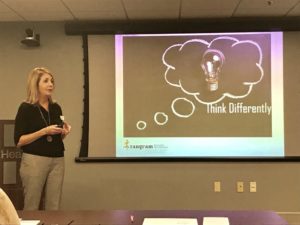If you received a resume, would you pass over a qualified candidate if they identified themselves as having a disability? It’s a thought-provoking question because for some companies whose leadership have made inclusion and accommodations a priority, the answer is no. For companies that are unfamiliar, the fears and stigmas of employing an individual with a disability take over and the resume may be pushed to the side–even if the candidate was qualified for the position.
This question was posed to attendees during a recent lunch and learn session hosted by Tangram Business Resourcing, a local Indianapolis nonprofit organization that offers consultation to businesses on the bottom line benefits of integrating people with disabilities into the workforce. The overarching theme of the luncheon was Missed Opportunities and taking a deep dive into what may be missed if your organization is not disability inclusive. Tangram representative, Kathy Bernhardt, asked attendees to think differently and look at the wide spectrum of disabilities–both physical and invisible (or hidden) disabilities. She cited that nearly 1 in 4 Americans, or 57 million individuals, are classified as having a disability–making this segment of the labor market the largest “untapped” talent pool that spans all EEO reporting areas. Therefore, if employers are excluding this segment from hiring, they are missing opportunities for innovation, growth and expansion.

Managing Director Kathy Bernhardt kicks off the lunch and learn encouraging attendees to think differently about disability hiring.
In terms of disability inclusion, Kathy also focused on these three key questions:
- Do you have a welcoming culture?
- Are you job descriptions inclusive?
- Is leadership driving diversity?
A welcoming, inclusive culture often starts from the top down and that culture then evolves with the needs of the business, but I found the question regarding the job description inclusivity to be the most compelling. What language is being used in your job description? Are your job descriptions providing detailed information on the position, or is it just a high-level overview? According to Kathy, individuals with disabilities prefer full details of what the job entails–including information on environmental factors, breakdown of physical requirements, schedule and location, etc. These additional details can ensure that candidates can identify if the position would be a good match for them in the long run.
Finally, Kathy encouraged employers to cast a wider net, and look at disability inclusion as a solution. She cited that employers hiring individuals with disabilities experience a 14% higher retention rate in the same roles when compared to their non-disabled counterparts and a 33% decrease in interview to hire ratios. From innovation and expanded ways of thinking, disability inclusion programs also offer companies incredible ROI, including:
- Reduced turnover
- Lower recruiting costs
- Access to an untapped labor pool
- Increased productivity and workplace safety
- Tax credits and incentives
- Increased customer outreach
Wrapping up the event, Kathy challenged attendees to address biases, stigmas and fears head on and educate themselves on the disability community. Not only will it help you embrace the disability community, but will shine light on how to remove the barriers from your organization and eliminate any missed opportunities you may have to find the right candidate for the job.
For tips on interviewing people with disabilities from start to finish, visit the Partner Marketplace in the Connect Community to access our newest employer resource from Tangram Business Resourcing.
